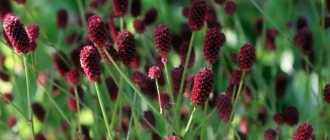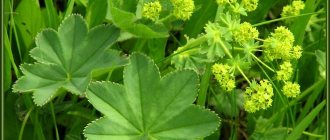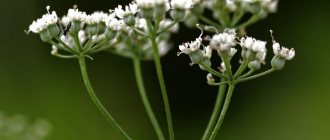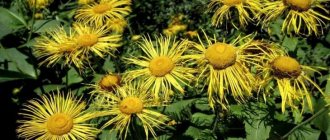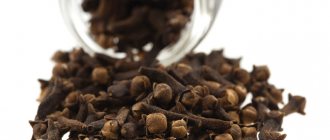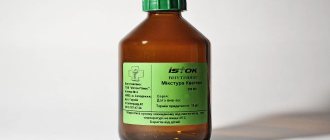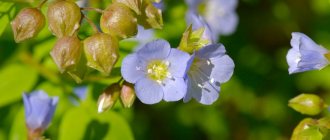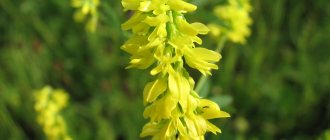Description of the plant
The most famous types of plantain are lanceolate, sandy, and middle. Pronounced medicinal characteristics are inherent in flea plantain, and also to a greater extent in large plantain. Of these two types, the latter is in high demand.
Great plantain is a familiar herb to many people and is often considered a nasty weed. In Latin the name sounds like Plantago major. Found everywhere, excluding the Far North. Due to its beneficial properties, the plant has been cultivated in a number of regions.
Description of plantain:
- the shortened rhizome of the plant is covered with numerous thread-like roots;
- broadly oval petiolate leaves are combined into a rosette located in the root zone;
- finely grooved erect peduncles reach a height of 14-46 cm;
- four-membered miniature flowers are collected in elongated spike-shaped inflorescences of a cylindrical shape;
- The fruit is a multi-seeded capsule.
Compound
The beneficial qualities of the weed plant are determined by the diverse chemical composition of plantain, including carotenoids, mucus, iron, cobalt, and choline.
Present in the structural formula are phytoncides, polysaccharides, magnesium, iridoid glycoside aucubin, and retinol. Includes bitter, nitrogenous, tannin compounds, vitamin K, selenium. Acids were identified - citric, ascorbic, uronic.
Plant species
There are many types of plantain in nature, and no matter how useful it is, biology officially classifies it as a weed. However, this does not prevent the humble plant from being regularly used in various medicines and being a real hero of folk medicine.
Among the most common species in our country are:
- big;
- flea or flea infested;
- lanceolate;
- average;
- Asiatic.
This plant has a small but developed rhizome. Its leaves have a characteristic oval shape and are located in a basal rosette.
The flowers have the appearance of a long spike and can reach a height of 10 to 25 centimeters.
What are the benefits of plantain for the human body?
When using a medicinal herb, it is important to consider the specific medicinal properties of plantain:
- wound healing;
- antiseptic;
- sleeping pills;
- antipyretics;
- bactericidal;
- enveloping;
- anti-inflammatory;
- antimycotic;
- painkillers;
- hemostatic;
- antimicrobial;
- sedatives;
- antiallergic;
- regenerating;
- expectorants.
The diverse beneficial properties of plantain help alleviate the condition caused by the development of inflammatory processes in the kidneys, gall and bladder. The plant helps eliminate diarrhea, allergic manifestations, stabilize sugar concentrations, and reduce cholesterol levels.
Taking into account the certain healing properties of plantain, products recommended for lung cancer and stomach cancer are prepared on the basis of this raw material. They are effectively used to treat tuberculosis, asthma, bronchitis, peptic ulcers, and whooping cough.
In the state of fresh juice, the medicinal properties of plantain are manifested for anacid gastritis and various skin lesions. The plant accelerates the healing of ulcers, cuts, wounds, abrasions, and boils.
Benefits for women
Plantain is useful for women, as its seeds have a beneficial effect on the functions of the reproductive system. Roots and leaves help relieve inflammation.
Herbal remedies are successfully used to perform douching procedures for cervical erosion. During excessive uterine bleeding, ingestion of plantain infusion is indicated. The product helps reduce pain during menstruation.
During pregnancy, plantain herb should be introduced into a therapeutic complex only with the permission of a doctor. Breastfeeding women are allowed to use water infusions and medicinal decoctions from the plant, but they need to monitor the baby’s reaction.
How it will help men
It is recommended to use healing plantain for men to increase potency. The rhizomes of the plant should be used to make the medicinal product.
The herb is valued for its ability to increase blood flow, which helps intensify spermatogenesis.
Healing properties and indications for use
Plantain is a valuable medicinal plant distributed throughout the globe. However, many people consider it a common weed and do not believe that roadside weed can heal as well as a patent medicine. What is the unique power of the plant?
As a result of many years of phytochemical research, it has been proven that plantain has wound-healing, disinfectant and anti-inflammatory effects. The juice of the plant is especially effective in this regard.
Attention. Freshly squeezed juice has a pronounced hemostatic and antiseptic effect.
A leaf applied to a sore spot perfectly disinfects the affected tissue, relieves pain, draws out pus and accelerates healing. Thanks to such unique properties, plantain is widely used in the treatment of the following injuries and injuries:
- bruises, contusions, abrasions and scratches;
- purulent wounds and boils;
- cuts;
- burns;
- calluses.
If an accident happens and you fall, get burned or injured, do not rush to the pharmacy. Look around and look for a plantain bush.
Potential Harm
Despite the variety of healing properties, it is necessary to take into account specific contraindications of plantain:
- excessive blood clotting;
- excess acid reflux;
- predisposition to thrombosis;
- individual intolerance.
Women who are breastfeeding or carrying a child must first obtain medical permission.
Beneficial properties of plantain for health and beauty
1. Animal studies have shown that plantain extract reduces signs of liver inflammation, and the plant's seeds can slow the growth of some malignant cells. This, of course, is not a panacea for cancer, but scientists continue their experiments.
2. Plantain seeds and leaves improve bowel function and help in treating diarrhea.
3. Plantain heals wounds, reduces inflammation, blocks the growth of germs and relieves pain. Only it must be crushed so that it releases juice, and then applied to the wound.
4. Plantain reduces the level of “bad” cholesterol, and a decoction of its leaves is a good expectorant for a debilitating cough with difficult to clear or viscous sputum.
5. Infusion of plantain leaves is an excellent moisturizer for the care of dry skin and hair.
6. Baths with the addition of plantain infusion are used to treat wounds and cracks on the feet. Compresses made from crushed leaves are also quite effective for softening calluses.
Use in medicine
The benefits of plantain in the form of an alcohol tincture for hypertension are known. Due to its expectorant properties, the plant is included in effective chest collections.
You can purchase the Plantaglucid suspension at the pharmacy as prescribed by a doctor, the base of which is an aqueous extract of plantain. Taking the drug is indicated for dysbacteriosis, peptic ulcers, cough, gastritis, pneumonia, bronchitis.
"Gerbion" - plantain cough syrup - is used successfully. To cope with constipation, use Fibrolax.
Dried parts of the plant are sold in pharmacies. Medicines are prepared from them independently. Be sure to first study the instructions for using plantain, which determine the required proportions and dosages.
Chemical composition
Great plantain has a rich and unique chemical composition. The leaves of the plant contain vitamin K and a considerable amount of vitamin C (289 mg%), citric and oleic acids and in addition a large percentage of nitrogenous and non-nitrogenous extractive substances, fiber, fats, glycoside aucubin, flavonoids, carbohydrate beckons, tannins, bitterness. Particular attention should be paid to the fact that the leaves of the great plantain contain a whole list of macro- and microelements, among which the first place is occupied by potassium (44.6 mg/g) and calcium (39.3 mg/g), as well as iron and manganese , copper, zinc, cobalt, molybdenum, chromium, barium, vanadium, selenium, nickel, strontium, lead and boron. Plantain seeds contain a large percentage (up to 44%) of mucilage, fatty oil (20%), protein (22%) and amino acids (16%), and also contain plantose and steroid saponins.
Folk remedies
Alternative medicine successfully uses plantain to produce a variety of medicinal compounds that have a beneficial effect on the body.
Tea
You will need dried plantain seeds, purchased at the pharmacy.
Preparation:
- Measure out 1 tbsp. l. plant seed.
- Pour into a faience glass.
- Pour in 50 ml. boiled water cooled to 40 degrees.
- After 25 minutes, pour the raw material onto a strainer to drain the liquid.
- The swollen seeds are placed back into the glass.
- Steam 200 ml. boiling water
- Leave under a thick linen cloth for 30 minutes.
The finished plantain tea is decanted, divided into three equal portions, and consumed throughout the day.
Decoction
For preparation, take the dried, crushed aerial part of the medicinal plant.
How to cook:
- Place 3 tbsp. l. raw materials into an enamel saucepan.
- Pour a glass of cool water over the grass.
- Place the container on the stove.
- After boiling, cook on low heat for 25 minutes.
- The plantain decoction is cooled.
- Filter using double gauze.
Infusion
You can quickly prepare a healing infusion of plantain if you use a thermos.
Sequencing:
- Dried plantain leaves are crushed.
- Transfer 4 tbsp. l. prepared raw materials in a thermos.
- Pour in a liter of boiled water.
- Leave for a quarter of an hour.
- Squeeze out the medicinal liquid through gauze.
Tincture
For medicinal purposes at home, plantain tincture is often used.
Preparation:
- Collect fresh leaf blades of the plant.
- Rinse.
- Wipe with a soft cloth.
- Pass the raw materials through a meat grinder (or turn into pulp using a blender).
- Squeeze out the juice quickly.
- Pour into a glass container.
- Add the same amount of vodka (equal to juice).
- Keep the hermetically sealed vessel in a closet for three weeks.
The finished tincture is used for its intended purpose.
Directions for use and doses
The method of administration and dosage regimen of a particular drug depend on its release form and other factors. The optimal dosage regimen is determined by the doctor. The compliance of the dosage form of a particular drug with the indications for use and dosage regimen should be strictly observed.
To treat gastrointestinal diseases, plantain is used orally in the form of a prepared infusion of 15-50 ml 15-30 minutes before meals. The course of treatment is 1-8 weeks. Juice is used 1 tbsp. spoon (dissolved in 50 ml of warm water) 15-20 minutes before meals 3-4 times a day for 1 month.
For the treatment of respiratory diseases, plantain is used in the form of infusion or juice in the same doses but 30 minutes after meals. For colds, juice diluted 5-10 times with warm water can be instilled 2-3 drops into each nostril 3-6 times a day.
For the treatment of dermatological diseases, the juice and infusion can be used externally in the form of dressings, lotions or rinses, 3-4 times a day, and for burns - regularly, with an interval of 1-1.5 hours.
In gynecological practice, juice is used in the form of douches, baths, instillations, and vaginal tampons.
Uses of plantain
Treatment with plantain is practiced for a variety of diseases. Proper use of products based on this plant greatly alleviates the condition.
Stomach treatment
Considering its enveloping, regenerating, anti-inflammatory characteristics, plantain for the stomach is successfully used in non-traditional healing practices. The plant promotes the healing of lesions of the mucous membranes.
Plantain is successfully used for gastritis that develops against the background of insufficient acidity. It is included in the general therapeutic complex. To relieve severe pain, take a teaspoon of dried plant seed. Transfer to earthenware dishes and steam 200 ml. boiling water.
A quarter of an hour before breakfast, drink the strained infusion. The treatment course lasts two months.
Plantain helps well with stomach ulcers. It is recommended to take 20 ml of tea from the plant. every four hours.
For the intestines
Due to its analgesic, bactericidal, and anti-inflammatory properties, traditional healers use plantain for the intestines.
If pain occurs, you will need the inflorescences of the plant in dry crushed form. They are boiled for 15 minutes in 300 ml. water. Drink the filtered cooled decoction if necessary at the time of pain.
For joints
The unique plantain is useful for joints. To relieve pain and swelling, soak a soft linen napkin with a decoction of the plant and apply it to the affected area. Cover with film, wrap in a warm scarf, leaving for 4-5 hours. It is useful to do this compress at night.
For hemorrhoids
Due to its anti-edematous, analgesic, hemostatic, anti-inflammatory properties, plantain is used with high effectiveness for hemorrhoids.
When used externally, decoctions and infusions are beneficial. Cotton swabs soaked in healing liquid are applied to the inflamed nodes several times a day.
A good effect is observed if these products are used for microscopic enemas, practiced in the morning and evening.
In gynecology
Plantain is used in gynecology for a variety of pathological problems.
To get rid of adhesions, combine dried seeds and crushed leaves of the plant - a tablespoon at a time. Infuse for 35 minutes in a cup of boiling water. Strained infusion 20 ml. taken twice a day.
For infertility:
- Take dried plantain seeds - 1 tbsp. l.
- Pour in 200-220 ml. boiled water.
- Cook the mixture at the minimum temperature for 5-6 minutes.
- The cooled broth is filtered.
Drink 20 ml three times a day. The treatment course is 1.5 - 2 months.
When losing weight
Nutritionists recommend using plantain for weight loss, since the herb intensifies intestinal processes, eliminates constipation, and activates metabolism. It is advisable to drink 1/3 cup of infusion prepared from dried leaves in a thermos daily on an empty stomach.
The husk of plantain seeds - psyllium, which has an effect similar to fiber, is valued. This safe substance activates the elimination of toxins, stabilizes the water-salt balance, muffles the feeling of hunger, has a mild laxative effect, and intensifies digestion.
Take one capsule half an hour before breakfast, and also after dinner. Take with water or any other drink.
Beneficial effects of plantain
This plant is truly universal: it can be used as food and used as compresses, it is equally useful for adults and children.
Rhizomes
The root of the plant contains substances that have analgesic and anti-inflammatory effects. Tinctures prepared from the roots are used to relieve toothache, as well as periodontal disease and herpes.
Leaves
The leaves of the plant are famous for helping to stop bleeding and are often used for cuts and bruises: just apply them to the wound.
This part of the plantain contains:
- potassium;
- glycosides;
- alkaloids;
- polysaccharides;
- tannins;
- chlorophyll;
- vitamin C;
- vitamin K.
Fresh leaves can also be used in cooking, for example by chopping them and adding them to a green salad.
Drying leaves does not require special skills or equipment. It is important to find a place for this purpose with good ventilation and protected from natural precipitation. Attics and sheds are ideal. The leaves need to be spread on the paper in a thin layer and turned over periodically. As soon as you notice that the cuttings have begun to crack and form husks, you can store the raw materials in fabric bags.
The shelf life of such preparations is about two years. They need to be kept in a dry place, away from direct sunlight and strong humidity.
Seeds
Plantain seeds contain essential oil, oleic acid and various organic compounds that have the following effects:
- heal cuts and abrasions;
- disinfect wounds;
- relieve an allergic reaction;
- reduce pain;
- have an expectorant effect;
- help stop bleeding;
- promote tissue regeneration;
- fight inflammation;
- protect against bacteria;
- have a general strengthening effect.
In home cosmetology
Plantain grass is in demand in the field of cosmetology. The plant helps improve the condition of weakened, dull hair, reduces oily skin, and effectively fights acne.
For face
If you use plantain correctly on your face, you will be able to effectively moisturize the skin, cleanse pores, even out the shade, and smooth out minor wrinkles.
For homemade tonic:
- 2 tbsp. l. of ground dry herb is steamed with actively boiling water - 200 ml.
- The cooled infusion, strained through a strainer, is distributed into molds.
- Freeze.
- Use in the morning to wash your face.
After just three weeks, the skin acquires a glow, becomes more elastic and fresh.
Plantain has been successfully used for acne. To cleanse problem skin:
- Dry leaves of the plant - 4 tbsp. l. placed in a bottle with 40 ml of alcohol diluted in 200 ml of filtered water.
- They insist for a week.
- Squeeze out the liquid through two layers of gauze.
Wipe acne-covered areas of the face with lotion twice a day.
For hair
It is recommended to use plantain for hair to strengthen and eliminate dandruff:
- Rinse fresh leaves.
- Wipe with a cloth.
- Chop or grind in a meat grinder.
- Squeeze out the juice thoroughly.
- Rub into hair roots.
- Wash off after two hours.
Repeat at intervals of two days.
Contraindications and harm
For certain ailments, using plantain is not recommended. As a rule, we are talking about the following diseases:
- chronic diseases of the gastrointestinal tract in the acute phase;
- gastritis with high acidity;
- problems with blood clotting;
- allergy to plantain.
Let me remind you that side effects from using this plant may include the following:
- nausea and vomiting;
- abdominal pain;
- diarrhea;
- dizziness.
Carefully monitor your body's reaction to plantain preparations, and if you experience any suspicious sensations or deterioration in your health, consult a doctor immediately.
HealthApply plantain: 10 popular misconceptions about health
Text: Olga Polevikova
Folk wisdom is similar in nature to gossip : it would seem that there is a grain of truth, but it is very difficult to get to the bottom of it. First, during the summer holidays, we learn about the magical properties of plantain from our grandmother, then our mother scolds us for reading with a flashlight under the blanket and damaging our eyesight, and then homeopathy is not far away. That there are myths - even some generally accepted “truths” sometimes do not stand up to scrutiny. It is useful to refer to them from time to time in order to understand where is scientific fact and where is folk wisdom. We selected ten popular ideas about health and treatment and found out whether there is at least some truth in them.
Vitamin C can save you from colds and flu
Vitamin C is involved in a huge number of metabolic processes in the body, including helping to cope with emotional and physical stress. Ascorbic acid is known to reduce cortisol levels and speed up the body's recovery after heavy exercise, which is why athletes love it. But no scientific evidence has been found that this vitamin helps fight colds and flu.
It has been experimentally shown to help prevent colds during periods of brief and extreme physical activity at low temperatures, such as marathon runners and skiers or soldiers in subarctic climates, but there is no detailed explanation for this phenomenon yet. In all other cases, it is better to regularly eat broccoli, tomatoes, lemons and other foods containing vitamin C for the normal functioning of the body. Ascorbic acid does not accumulate, so you shouldn’t gobble up kilograms of oranges: the daily dose for an adult is 75–90 mg.
Reading in the dark affects your vision
The main cause of poor vision is genetics. If the parents had poor eyesight, then with a 40% probability the story will repeat itself in their children. Another common problem is computer vision syndrome, which occurs when the distance to the screen is incorrect while working with electronic devices. So at an appointment with an ophthalmologist, it will be more important whether your mother wears glasses and how your workplace is set up, rather than whether you like to read without a desk lamp.
A study published in 2007 in The BMJ refutes the myth that reading in the dark is harmful. At night it is really more difficult to focus, a person blinks less often, the surface of the eyeball dries out, which creates a feeling of discomfort. But such tension passes without harm to the eyes. Much of today's research and scientific debate revolves around the effects of working with close objects and head position on vision. For example, there is evidence that reading on your back is not as harmful as sitting and looking down at a book.
During illness, you need to eat heavily to gain strength.
During a cold or flu, it is important to continue to eat normally, but feeling unwell is not a reason to overeat. When the body fights an infection, it needs energy, which means it needs to supply calories and nutrients. This is especially important during a fever: elevated temperature is a mechanism of the immune system that triggers an accelerated metabolism. Each degree requires more and more energy, and therefore calories. At the same time, it is important not to burden the body with digesting heavy food: all efforts should be devoted to defeating the infection. So it’s better to avoid pork ribs and sandwiches in favor of low-fat chicken broth: it’s liquid, warm, and moderately high in calories.
When you have a cold, you need to sweat to get better faster
Sweat helps the body cool down and remove toxins and appears on the body when the heat subsides. A high temperature is needed in order to mobilize the immune system, so if it is below 38.5 degrees, it is better to give the body a chance to fight it on its own. Sweat is more of a signal that you are getting better, rather than the cause of what is happening. However, there appear to be no large-scale scientific studies on the relationship between sweating and the speed of recovery.
There is also a belief that going to the bathhouse will help with the initial symptoms of a cold. Austrian scientists tested this assumption and observed a group of 50 men for six months: half regularly went to the sauna, half did not. Among those who steamed, there were indeed fewer cases of colds than in the control group, but, as scientists note, it is too early to draw conclusions and further tests are needed.
Skin lesions heal better when exposed to air
Just the opposite: air dries out the epidermis and slows down the formation of new cells. In addition, an unhealed open wound can easily become infected. For regeneration, it is better that the wound is covered with a bandage or plaster - this way the environment will be moisturized and protected from bacteria. The wound should be washed regularly and the bandage or bandage changed at least once a day.
Forget about plantain: an unwashed leaf from a bush from the side of the road will yield nothing but more germs. But if you “blow on the wound,” the crust actually forms faster—in about three hours instead of the usual day for this process, however, more tissue will die. So, according to scientists, it is possible to blow on the damage, but it is worth doing this only if the rapid formation of a crust will help avoid infection - for example, with large burns.
Taking calcium with vitamin D strengthens our bones
Human bones contain 99.5% of the body's calcium, and vitamin D helps us absorb it from food. Vitamin D is synthesized under the influence of the sun and also enters the body with food. It is believed that it is difficult to fill the daily requirement with food alone. Thus, the US National Institutes of Health recommends taking about 15 mcg of vitamin D supplements per day, and after age 65 increasing the dose to 20 mcg, since the risk of developing osteoporosis increases with age. However, according to some data, for women after menopause, increasing the dose does not lead to the desired effect and, on the contrary, provokes the formation of kidney stones. Be that as it may, at any age, before using dietary supplements and vitamins, it is better to consult a doctor.
Tea with honey and lemon will cure colds
It will not cure, but it may relieve symptoms. During acute respiratory infections, it is recommended to drink a lot of fluid: it removes toxins through sweating and urine, prevents dehydration and eases the pain of an inflamed nasopharynx due to vasodilation. Another thing is that the liquid can be anything: water, juice, milk, including tea with honey and lemon. Black tea contains caffeine, which increases the overall tone of the body, so you will perk up for a short time, which, however, does not mean victory over the virus.
There is no scientific evidence for the benefits of honey and lemon for colds. We have already figured out the real effect of vitamin C - as for honey, it helps soften a cough. If you have a sore throat, however, it should be used with caution as it may increase irritation. It is worth remembering that at temperatures above 37 degrees honey loses its beneficial properties, so it is better to eat a teaspoon just like that rather than adding it to a drink.
Blueberries help restore vision
Legend has it that during the Second World War, Royal Air Force pilots ate blueberry jam before each night flight to better see enemy targets. Blueberries actually contain the pigment lutein, which is important for the normal functioning of the eye: it protects it from excess light and from ultraviolet radiation. There was no evidence that lutein helps to see in the dark and restores visual acuity. It is not synthesized by the human body and mainly accumulates in the retina. There are no recommendations on the daily intake of lutein, nor is there an understanding in what form it is more effectively absorbed - from food or from dietary supplements. On the other hand, research confirms that a diet rich in lutein reduces the risk of age-related diseases such as cataracts and retinal degeneration. It is recommended to take it in combination with the pigment zeaxanthin and vitamins C and E.
Acne is caused by poor diet
Acne is a tricky thing. Characteristic inflammations can appear at any age, and it is impossible to single out a single cause for their occurrence. Genetics, stress, hormones, nutrition, hygiene - there are many factors, and it is difficult to predict which of them will shoot out and provoke disruption of the sebaceous glands. The appearance of acne may indicate various types of problems in the body: even a few systematically recurring pimples are a reason to consult a doctor, if only to make sure that your health is within normal limits.
As for food, scientists are not yet completely clear. Acne is blamed on foods high in simple carbohydrates and certain fatty acids, as well as dairy products. Research shows that there is a statistical relationship between these foods and acne, but whether this is a cause-and-effect relationship is not yet known. In any case, a healthy diet has never hurt anyone.
Crackling your fingers can give you arthritis.
Popular rumor says that if you stretch sweetly until your joints crunch or stretch your fingers, imitating the sound of cracking nuts, then arthritis will occur in old age. There is actually no medical evidence for this. But there are two possible causes of crunching bones. First: when stretching, the joint capsule stretches, the pressure in it drops, the joint fluid spreads, and gas bubbles form - they burst with a click. Second: the sound occurs when moving due to rapidly stretching ligaments and tendons. In any case, the worst thing that threatens a lover of cracking joints is the irritated glances of others.
Photos: margo555 – stock.adobe.com, nipaporn – stock.adobe.com, Africa Studio – stock.adobe.com, fox17 – stock.adobe.com
Plantain for food
Young plantain leaves can be eaten. They have a slightly bitter taste, so test first to see if you like these greens. Add the leaves to salads of seasonal vegetables and herbs, omelettes, casseroles, vegetable filling for pies, minced meat for cutlets, or prepare green sauce a la pesto.
“A la pesto” of green onions and plantain
- Coarsely chop 200 g of green onions (along with white onions) and 40-50 g of plantain leaves.
- Place in a blender bowl.
- Add 80-100 ml of mild-tasting extra virgin olive oil and 30-40 g of young, peeled walnuts (they shouldn’t even be a little bitter!). Punch the mixture until smooth. Season with salt and pepper.
- Add, if desired, 40-50 g of cottage cheese and mix. Serve with toast, croutons or bread as a spread.
Older plantain leaves become tough, but still remain edible. But then they are better used in soups, stews and stews. There are even recipes for cabbage rolls where the leaves of this essentially weed are used instead of cabbage. And some lovers of canned vegetables advise using plantain when pickling tomatoes and cucumbers - supposedly this gives the preparations an unusual taste of summer.
Plantain leaves have several arched, very strong veins - “vessels”. Thanks to them, the leaves do not break and successfully resist trampling.
